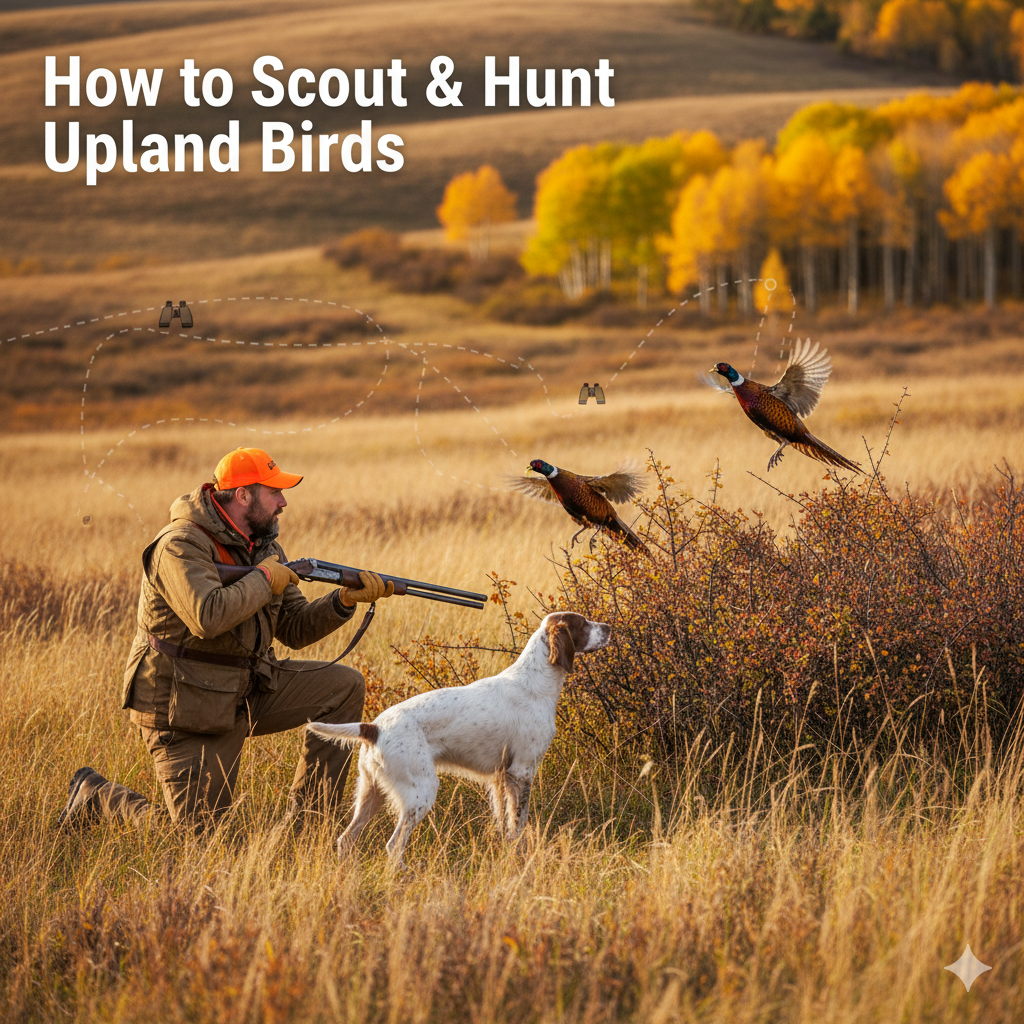
Upland bird hunting especially for pheasant and quail is one of the most rewarding pursuits in the field. It combines strategy, habitat knowledge, physical skill, and a keen understanding of bird behavior. Whether you’re chasing early-season quail in brushy cover or late-season roosters in tall CRP grass, success depends heavily on proper scouting, effective hunting tactics, and efficient use of your gear and dog.
In this comprehensive guide, you’ll learn exactly how to scout, locate, pattern, and hunt upland birds like pheasant and quail, plus essential gear tips, dog strategies, and field-tested techniques used by seasoned upland hunters.
Great upland hunters always start with bird knowledge. Pheasant and quail move predictably throughout the day based on cover, food, temperature, and pressure.
Table of Contents
Understanding these patterns is the foundation of productive scouting.
Scouting is the difference between walking miles blindly and walking into birds confidently. Here’s how to scout like a pro.
✔ CRP grasslands
✔ Corn and milo fields (especially harvested edges)
✔ Shelterbelts, windbreak trees
✔ Creek bottoms
✔ Cattail sloughs (late season goldmine)
✔ Brushy fence lines
✔ Mixed grass & brush edges
✔ Hedgerows, briars, plum thickets
✔ Overgrown pastures
✔ Oak scrub flats
✔ Field edges with water sources nearby
✔ Weedy fencerows and abandoned homesteads
These birds require the “holy trinity” of habitat:
Food + Cover + Water.
Anywhere that checks all three boxes is worth scouting.
When scouting on foot or by binocular:
Quail often give themselves away with soft “koi-lee” calls near daylight.
Use digital tools before stepping foot in the field:
Mark promising areas, then confirm by walking or glassing.
Better scouting = fewer empty miles during the hunt.
Pheasants are among the most exciting upland birds to hunt but also the smartest. Here’s how to consistently take roosters.
Roosters love transition zones:
Walk edges first before diving into thick cover.
Pheasants run long before they fly. Block escape routes.
If solo, work crosswinds and zig-zag slower than normal to keep birds from running too far ahead.
A dog needs scent advantage.
Roosters are notorious for flushing behind hunters who walk with the wind at their backs.
Most new hunters walk too fast.
Slow, intentional steps cause pheasants to:
Stop every 20–30 yards; birds often flush when you pause.
Experienced hunters always hit:
✔ Corners of fields
✔ Dead-end pockets
✔ Thick cattails (late season)
✔ Willow draws
✔ Abandoned farm structures
These spots concentrate birds under pressure.
Quail hunting is fast, explosive, and requires quick reaction. Here’s how to do it right.
Quail almost never sit in wide-open grasslands. Work:
Move slowly, gun ready.
When a covey flushes:
After the initial flush, mark the general landing area and go after singles they’re easier to approach.
Dogs are a massive advantage for quail:
Pointers hold birds for a clean approach.
Flushers push birds into the air from tight cover.
No dog? Slow down and watch for:
Quail burst fast and low. Always ensure:
Safety is always first.
While you can hunt upland birds without a dog, nothing matches the effectiveness of a trained bird dog.
These breeds excel in dense cover and long days.
Pointers shine for covey hunting due to strong scent detection.
Your dog’s nose is your greatest scouting tool.
You don’t need excessive gear but you need the right gear.
For pheasant:
For quail:
Choose durable, briar-resistant clothing:
Bird behavior changes drastically through the season.
Birds are:
Target:
Dogs can track easier due to mild temps.
Birds start getting smart.
Strategy:
Cold weather concentrates birds in thick cover.
For pheasant:
For quail:
Late-season hunts reward endurance and persistence.
Safety ensures seasons for years to come.
✔ Hunt where other hunters don’t
✔ Be patient slow walking finds more birds
✔ Scout more than you shoot
✔ Learn to read bird tracks and habitat transitions
✔ Trust your dog
✔ Don’t give up after a dry field move to the next habitat edge
Master upland hunting, and every season becomes a new adventure.
Hunting upland birds like pheasant and quail is a blend of art and strategy. When you learn how to scout effectively, read habitat, understand bird behavior, and use the right gear and dog tactics, your success rate increases dramatically.
A hunting rifle is more than just a tool it’s a trusted companion in the…
Choosing the best tree stands under $300 is one of the smartest investments a hunter…
When dark clouds roll in and rain starts falling, many hunters pack up their gear…
Competitive shooting requires skill, precision, and the right equipment. Whether you're a seasoned competitor or…
The world of archery is undergoing an exciting evolution. What once were purely mechanical tools…
Welcome to the latest 2025 hunting-season guide, tailored for readers of TheShootingGears. Whether you’re carving…
This website uses cookies.